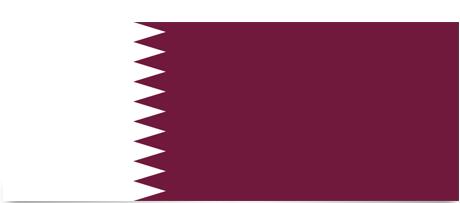Qatar Flag and Meaning
Flag of Qatar

Qatar Flag Meaning
Usually, most Arab flags along the Persian Gulf have been more or less red. The purple hue that Qatar uses in its flag is said to come from a specific red dye that assumes a purple hue when exposed to the sun’s strong rays in the Arabian desert. The flag is similar to the Bahrain flag but what distinguishes them this year is the color and number of teeth ?? which separates the purple color from the white. The flag of Bahrain, like most Arab flags, is red in color.
The Qatari flag was adopted in 1949, and became state-mandated on July 1, 1971.
Qatar Overview
| Population | 600000 |
| currency | Qatar riyals |
| Area | 11,000 km² |
| Capital city | Doha (Ad-Dawhah) |
| Population density | 54.5 residents/km² |
| HDI location | 38 |
Qatar Peninsula is located on the east coast of the Arabian Peninsula off to the Persian Gulf. The climate is dry and characterized by desert. The landscape is flat. Only residents the narrow coastal area is it possible to practice some farming. The country’s most important resource is its huge oil reserves on the west coast of the peninsula. The country continues to suffer from the aftermath of the extensive pollution that arose. the fires during the 1991 Gulf War.
Monarchy and dictatorship supported by EU and US.
The people: The original Arab population constitutes a minority with 20% today. However, the Arabs as an ethnic group still constitute a majority due to extensive immigration, of which 25% are Palestinians, Egyptians and Yemenites. The other 55% of the population is predominantly Pakistani, Iranian and Indian immigrants.
Religion: Islam (official and dominant). The majority are Sunni, while Iranian immigrants are Shiites. Furthermore, there are Christian and Hindu minorities.
Languages: Arabic (official and dominant). Pakistani immigrants speak Urdu and Iranians Farsi. English is used as a business language.
Political parties: There are no organized legal political parties
Official Name: Dawlat Qatar
Capital: Doha (Ad-Dawhah), 998,000 residents (2008)
Other important cities: Rayyan, 183,000 residents; Al Wakrah, 22,900 residents; Umm Salal, 18,100 residents (2000)
Government: Simple monarchy. Sheik Tamim bin Hamad Al Thani has been Emir since June 2013; Abdullah bin Nasser bin Khalifa Al Thani has been the country’s prime minister since June 2013. There is a council of 45 members. The 30 are elected by ordinary elections for a 4-year term, while the remaining 15 are appointed by the emir. Islamic law is the basis of state law.
National Day: September 3 (Independence Day, 1971)
Armed Forces: 11,800 Soldiers (1996)













































